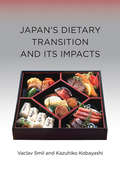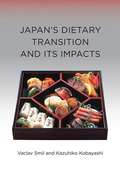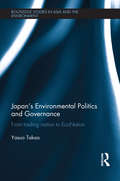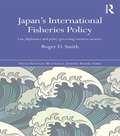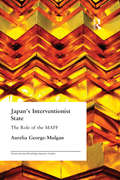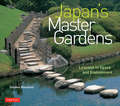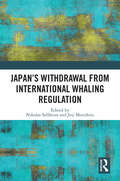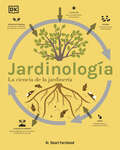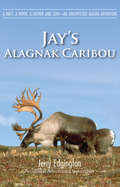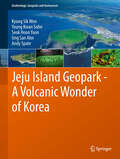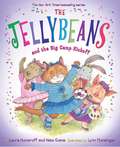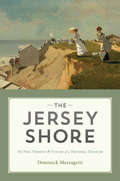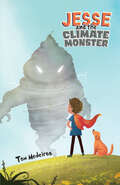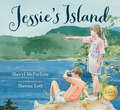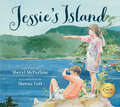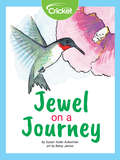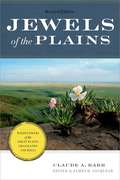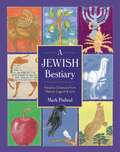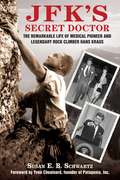- Table View
- List View
Japanese Woodblock Flower Prints
by Tanigami KônanExceptionally drawn in a realistic fashion and awash in spectacularly rich colors, this one-of-a-kind art book -- masterfully reprinted from a rare and costly edition -- combines the perennial appeal of flowers with the art of Japanese woodblock prints.Nothing expresses the richness and vigor of life like blooming flowers. A stunning showcase of 120 full-color plates, this specially chosen collection features beautiful Eastern and Western botanicals that will delight flower lovers, artists, designers, and devotees of fine art. Admire such familiar and unusual blossoms as the poppy, rose, anemone, cyclamen, delphinium, water lily, lupine, passion flower, allamanda, phlox, dahlia, petunia, tulip, freesia, pansy, begonia, and many more beautiful blooms!Tanigami Kônan (1879-1928) was a genius at the art of woodblock creation and color gradation, and he is still celebrated as one of the finest artists of this highly specialized technique. Captions and a complete index are included in this distinct keepsake edition.
Japan's Dietary Transition and Its Impacts (Food, Health, and the Environment)
by Vaclav Smil Kazuhiko KobayashiAn examination of the transformation of the Japanese diet from subsistence to abundance and an assessment of the consequences for health, longevity, and the environment.In a little more than a century, the Japanese diet has undergone a dramatic transformation. In 1900, a plant-based, near-subsistence diet was prevalent, with virtually no consumption of animal protein. By the beginning of the twenty-first century, Japan's consumption of meat, fish, and dairy had increased markedly (although it remained below that of high-income Western countries). This dietary transition was a key aspect of the modernization that made Japan the world's second largest economic power by the end of the twentieth century, and it has helped Japan achieve an enviable demographic primacy, with the world's highest life expectancy and a population that is generally healthier (and thinner) than that of other modern affluent countries. In this book, Vaclav Smil and Kazuhiko Kobayashi examine Japan's gradual but profound dietary change and investigate its consequences for health, longevity, and the environment.Smil and Kobayashi point out that the gains in the quality of Japan's diet have exacted a price in terms of land use changes, water requirements, and marine resource depletion; and because Japan imports so much of its food, this price is paid globally as well as domestically. The book's systematic analysis of these diverse consequences offers the most detailed account of Japan's dietary transition available in English.
Japan's Dietary Transition and Its Impacts
by Vaclav Smil Kazuhiko KobayashiIn a little more than a century, the Japanese diet has undergone a dramatic transformation. In 1900, a plant-based, near-subsistence diet was prevalent, with virtually no consumption of animal protein. By the beginning of the twenty-first century, Japan's consumption of meat, fish, and dairy had increased markedly (although it remained below that of high-income Western countries). This dietary transition was a key aspect of the modernization that made Japan the world's second largest economic power by the end of the twentieth century, and it has helped Japan achieve an enviable demographic primacy, with the world's highest life expectancy and a population that is generally healthier (and thinner) than that of other modern affluent countries. In this book, Vaclav Smil and Kazuhiko Kobayashi examine Japan's gradual but profound dietary change and investigate its consequences for health, longevity, and the environment. Smil and Kobayashi point out that the gains in the quality of Japan's diet have exacted a price in terms of land use changes, water requirements, and marine resource depletion; and because Japan imports so much of its food, this price is paid globally as well as domestically. The book's systematic analysis of these diverse consequences offers the most detailed account of Japan's dietary transition available in English.
Japan's Environmental Politics and Governance: From Trading Nation to EcoNation (Routledge Studies in Asia and the Environment)
by Yasuo TakaoEnvironmental issues stretch across scales of geographic space and require action at multiple levels of jurisdiction, including the individual level, community level, national level, and global level. Much of the scholarly work surrounding new approaches to environmental governance tends to overlook the role of sub-national governments, but this study examines the potential of sub-national participation to make policy choices which are congruent with global strategies and national mandates. This book investigates the emerging actors and new channels of Japan’s environmental governance which has been taking shape within an increasingly globalized international system. By analysing this important new phenomenon, it sheds light on the changing nature of Japan’s environmental policy and politics, and shows how the links between global strategies, national mandates and local action serve as an influential factor in Japan’s changing structures of environmental governance. Further, it demonstrates that decision-making competencies are shared between actors operating at different levels and in new spheres of authority, resulting from collaboration between state and non-state actors. It highlights a number of the problems, challenges, and critiques of the actors in environmental governance, as well as raising new empirical and theoretical puzzles for the future study of governance over environmental and global issues. Finally, it concludes that changes in the tiers and new spheres of authority are leading the nation towards an environmentally stable future positioned within socio-economic and political constraints. Demonstrating that bridging policy gaps between local action, national policy and global strategies is potentially a way of reinventing environmental policy, this book will be of interest to students and scholars of Environmental Studies, Environmental Politics and Japanese Politics.
Japan's International Fisheries Policy: Law, Diplomacy and Politics Governing Resource Security (Nissan Institute/Routledge Japanese Studies)
by Roger D. SmithFew nations rely upon the ocean as much as Japan for livelihood, culture and transport. The seas have long played a vital role for the Japanese, helping to support the economic and social life of a nation that possesses few resources and little arable land, and sustain a population that has nearly tripled in the last century. Fish are a distinctive feature of the Japanese diet, constituting nearly half of all animal protein consumed – the highest rate in the world. The industry itself has provided an impetus for coastal community growth and national economic development over the past century, while fisheries have worked their way into Japanese culture and customs, serving as a dominant symbol in traditional arts and folklore. This book explores the overarching rationale that motivated Japanese international fisheries policy throughout the post-war period until today, highlighting the importance of international fisheries to Japan and the stature this resource has occupied as a national interest. It provides a comparative view of Japanese foreign policy at various ocean conferences, treaty negotiations, bilateral diplomatic initiatives and other maritime relations that constitute ocean policy over half a century, and investigates the domestic constituents of national policy. Roger Smith argues that the rationale for international fisheries policy may be best viewed as deriving from Japan’s unique defence strategy for its national interests: comprehensive security. Encompassing non-military elements and most importantly defence of economic interests, Japan’s international fisheries policy provides an interesting case study of how comprehensive security is conceptualised and carried out. Taking a broad view of Japan’s international fisheries policies from 1945 to the present, this book highlights the key trends in policy motives and means throughout the post-war period. As such, it will be of great interest to students and scholars of Japanese studies, international and environmental law, resource management and international relations, as well as to policy makers working in the field.
Japan's Interventionist State: The Role of the MAFF (Nissan Institute/Routledge Japanese Studies)
by Aurelia George-MulganJapan's Interventionist State gives a detailed examination of Japan's Ministry of Agriculture, Forestry and Fisheries and its role in promoting, protecting and preserving the regime of agricultural support and protection. This account is integral to the author's extended and multidimensional explanation for why Japan continues to provide high levels of assistance to its farmers and why it continues to block market access concessions in the WTO and other agricultural trade talks.
Japan's Master Gardens
by Stephen MansfieldNo two Japanese gardens are ever the same. Each is inimitable, yet embodies commonalities of design and aesthetic taste. Each finds the space for innovation within a tradition that benefits from a thousand years of applied knowledge. Presenting twenty-five master gardens, Japan's Master Gardens explores the ingenuity and range of Japanese landscaping, from the self-imposed confines of courtyard designs to the open expanses of the stroll garden.Japan's Master Gardens illustrates how, through the ministrations of generations of gardeners, original landscapes have maintained their mastery and demonstrates how contemporary landscaping draws from tradition, making ancient gardens relevant to the lives of people in the twenty-first century.This beautifully illustrated book takes readers on an exploration of the outward forms, underpinning principles, complex use of metaphor and allusion, and beauty and depth that set the Japanese garden apart.
Japan's Withdrawal from International Whaling Regulation
by Nikolas Sellheim Joji MorishitaThis book examines the impact and implications of Japan's withdrawal from the International Convention for the Regulation of Whaling (ICRW), which came into effect in July 2019. In 1982 the International Whaling Commission (IWC) adopted a moratorium on commercial whaling which has been in effect ever since, despite the resistance of some countries, first and foremost Japan, Norway and Iceland, that engage in commercial whaling. As one of the key contributors to scientific research and funding, Japan's withdrawal has the potential to have wide-ranging implications and this volume examines the impact of Japan's withdrawal on the IWC itself, on the governance of whaling, and on indigenous and coastal whaling. It provides backgrounds and commentaries on this decision as well as normative and legal discussions on matters relating to sustainable use of resources, and philosophies surrounding whaling in different IWC countries. The consideration of other international environmental regimes, such as the Convention on International Trade in Endangered Species (CITES) are also examined in order to determine the international ripple effect of Japan’s decision. The book reveals that this is not just a matter of whaling but one which has significant legal, managerial and cultural implications. Drawing on deep analyses of IWC structures, the book addresses core philosophies underlying the whaling debate and in how far these may influence environmental governance in the future. This book will be of great interest to students and scholars of environmental law and governance, biodiversity conservation and sustainable development, as well as policymakers involved in international environmental and conservation agreements.
Japan's Withdrawal from International Whaling Regulation (Routledge Studies in Conservation and the Environment)
by Nikolas Sellheim Joji MorishitaThis book examines the impact and implications of Japan’s withdrawal from the International Convention for the Regulation of Whaling (ICRW), which came into effect in July 2019. In 1982 the International Whaling Commission (IWC) adopted a moratorium on commercial whaling which has been in effect ever since, despite the resistance of some countries, first and foremost Japan, Norway and Iceland, that engage in commercial whaling. As one of the key contributors to scientific research and funding, Japan’s withdrawal has the potential to have wide-ranging implications and this volume examines the impact of Japan’s withdrawal on the IWC itself, on the governance of whaling, and on indigenous and coastal whaling. It provides backgrounds and commentaries on this decision as well as normative and legal discussions on matters relating to sustainable use of resources, and philosophies surrounding whaling in different IWC countries. The consideration of other international environmental regimes, such as the Convention on International Trade in Endangered Species of Wild Fauna and Flora (CITES), is also examined in order to determine the international ripple effect of Japan’s decision. The book reveals that this is not just a matter of whaling but one which has significant legal, managerial and cultural implications. Drawing on deep analyses of IWC structures, the book addresses core philosophies underlying the whaling debate and in how far these may influence environmental governance in the future. This book will be of great interest to students and scholars of environmental law and governance, biodiversity conservation and sustainable development, as well as policymakers involved in international environmental and conservation agreements.
Jardines (¡Arriba la Lectura!, Level I #10)
by Heather Hammonds Ben SpibyNIMAC-sourced textbook. ¡Cuesta mucho trabajo mantener un jardín! Pero los jardines son el hogar de animales e insectos, y son lugares hermosos. ¿Qué trabajos importantes puedes hacer en el jardín?
Jardinología (The Science of Gardening): La ciencia de la jardinería
by Dr. Stuart FarrimondUn libro de jardinería diferente que explica la ciencia detrás de la jardinería de forma visual y clara.¿El mundo de la botánica y la jardinería te parecen un misterio? Las guías de jardinería al uso tienden a dar gran cantidad de instrucciones y consejos, pero rara vez aportan explicaciones sobre el por qué. ¡No te preocupes! El Dr. Stuart Farromond arroja luz sobre todas esas preguntas que siempre te has hecho y te explica lo que sucede en tu jardín desde un enfoque científico.La guía botánica definitiva para entender los secretos de la horticultura y la floricultura como un profesional:Escrita con un lenguaje accesible y libre de tecnicismos en formato pregunta y respuesta. Con explicaciones claras, apoyadas por gráficos y esquemas para ilustrar los conceptos de forma visual.Estructurado en torno al ciclo de vida de un jardín, desde los primeros brotes hasta el momento de la poda.Explica los beneficios de la jardinería para la salud mental y el medio ambiente.Un práctico manual de jardinería con explicaciones y consejos avalados por la ciencia, que te ayudará a comprender mejor cómo se comportan las plantas, desmitificar creencias y descubrir las bases y avances de la horticultura moderna. ------------------------The only book to explain the science behind gardening practice in a simple and visually accessible way.The world of gardening can be a mystifying place, with so many instructions to follow and often little explanation as to why. Dr. Stuart Farromond casts his scientific eye over a typical year in the garden to answer all the horticultural questions you&’ve ever wanted the answer to. This great gardening book provides a shortcut to decades of gardening experience by explaining the science behind how a garden grows, featuring: An accessible guide structured around the life cycle of the garden, taking you from first shoots to pruning for renewal. An accessible Q &A format, with stats and infographics to bring the story to life, as well as long-held gardening myths are exploded by new science. Every way to greener fingers has an action point so that you can understand the science, apply your gardening practice, and enjoy a flourishing garden.From hands-on, practical advice, to an exploration of the mental health benefits of gardening, while also covering topics such as the positive impact gardening can have on the earth during a time of climate crisis in between, The Science of Gardening debunks myths and reveals the latest science only taught at horticultural college. As a passionate newcomer to gardening, daunted by the mountain of often conflicting advice in gardening manuals, Dr. Stu has set about testing the scientific basis of so much conventional wisdom and practice so you too can garden like a pro.
Jay's Alagnak Caribou: A Raft, A River, A Father and Son—An Unexpected Alaska Adventure
by Jerry EdgingtonJay and his dad knew things would change after summer. The seasons of boy scouts, little league, high school sports, and just hanging out, would be gone forever. But there was a chapter left to write, and it would be written on a long section of the Alagnak River in Alaska. It wouldn't be the final chapter, not by a long stretch, but it would be a transcending chapter. A self-guided moose hunt and fishing trip would be a proper way to commemorate Jay's 19th birthday. So, with fishing rods and guns, and a flight into the headwaters of the Alagnak River they embarked on their adventure. What they found was more than they imagined—much more. They found the Alaska wilderness and a freedom they didn't know existed. They found a life changing adventure—built unbreakable bonds.
Jaywalking with the Irish
by David MonaganFrom the book: For David Monagan, born in Connecticut to a staunch Irish-American family, a lifelong interest in Ireland was perhaps inescapable. David studied literature at Dublin's Trinity College in 1973 and '74, and he became captivated by the country. After enjoying many visits in the intervening years, in 2000 David and his family relocated from the U.S. to Cork, Republic of Ireland. David has written for numerous publications, including the Irish Times, Sunday Independent, and Irish Examiner, and in his wide travels has developed a keen eye for things baffling and marvelous, such as he finds everywhere around him in modern-day Ireland.
Jeju Island Geopark - A Volcanic Wonder of Korea
by Andy Spate Kyung Sik Woo Seok Hoon Yoon Ung San Ahn Young Kwan SohnThis book will deal with geological as well as cultural, historical, archaeological and biological aspects in Jeju Global Geopark. It will start with introduction of Jeju Global Geopark, geographic setting, habitats, history, economy and tourism, management, general geology and geosites, future geosites, other significant heritage sites, economically sustainable tourism, education and promotion and management plan.
The Jellybeans and the Big Camp Kickoff
by Laura Joffe Numeroff Nate EvansThe Jellybeans are off to summer camp to enjoy ghost stories around the campfire, roasting marshmallows, and swimming in the lake. Each girl finds her own favorite activity: Emily goes to the dance studio, Bitsy does arts and crafts, and Anna reads about nature. But Nicole can't find anything that's just right for her. So she decides to start a soccer team and teach her friends her favorite game. Will the Jellybeans be able to win the big match against a neighboring camp? Once again, the girls use their different strengths and talents to work together and have the best summer ever. This third book in the successfulNew York Timesbestselling series shows that, whether readers are girly girls, bookworms, artists, or tomboys, there is a Jellybean for everyone.
Jellyfish: A Natural History
by Lisa-ann GershwinAn introduction to these bizarre and beautiful creatures of the sea, filled with color photos and illustrations: &“Fascinating.&”—Boing Boing Jellyfish are the oldest multi-organed life form on the planet, having inhabited the ocean for more than five hundred million years. With their undulating umbrella-shaped bells and sprawling tentacles, they are compelling and gorgeous, strange and dangerous. In many places they&’re also vastly increasing in number, and these population blooms may be an ominous indicator of the rising temperatures and toxicity of the oceans.Jellyfish presents these aquarium favorites in all their glory. Fifty unique species, from the purple people eater to black sea nettles, are presented in stunning photos along with the most current scientific information on their anatomy, history, distribution, position in the water, and environmental status. Foremost jellyfish expert Lisa-ann Gershwin provides an insightful look at the natural history and biology of each of these spellbinding creatures, plus a timely take on their place in the rapidly changing and deteriorating condition of the oceans. Learn about immortal jellyfish who live and die and live again—as well as those who camouflage themselves amid sea grasses and shells, hiding in plain sight. Discover the jellyfish that&’s the world&’s most venomous animal, and the jellyfish that helped scientists win the Nobel Prize. They&’re all here and more in this delightful volume. &“A thorough coverage of jellyfish history, biology and ecology. Gershwin, a marine biologist who has discovered over 200 new species of jellyfish, does an excellent job of combining a compelling narrative of 50 different jellyfish with luscious, I-can&’t-believe-they&’re-real photos.&”—Boing Boing
The Jersey Shore: The Past, Present & Future of a National Treasure
by Dominick MazzagettiIn The Jersey Shore, Dominick Mazzagetti provides a modern re-telling of the history, culture, and landscapes of this famous region, from the 1600s to the present. The Shore, from Sandy Hook to Cape May, became a national resort in the late 1800s and contributes enormously to New Jersey’s economy today. The devastation of Hurricane Sandy in 2012 underscored the area’s central place in the state’s identity and the rebuilding efforts after the storm restored its economic health. Divided into chronological and thematic sections, this book will attract general readers interested in the history of the Shore: how it appeared to early European explorers; how the earliest settlers came to the beaches for the whaling trade; the first attractions for tourists in the nineteenth century; and how the coming of railroads, and ultimately automobiles, transformed the Shore into a major vacation destination over a century later. Mazzagetti also explores how the impact of changing national mores on development, race relations, and the environment, impacted the Shore in recent decades and will into the future. Ultimately, this book is an enthusiastic and comprehensive portrait by a native son, whose passion for the region is shared by millions of beachgoers throughout the Northeast.
Jesse and the Climate Monster
by Tom MedeirosJesse and the Climate MonsterAn Introduction for parents and teachersAs the news of climate change and climate related disasters expands, our school age children are not immune to the feelings of fear and helplessness. Jesse and the Climate Monster, published as a bilingual (English/Spanish) book, allows young readers, their classmates and their families, an opportunity to begin to understand climate change as presented in an engaging tale. Within the story, early readers are exposed to many of the effects of climate change as Jesse relates the experiences of Jesse&’s classmates. In addition to the story, the accompanying links, activities, and illustrated glossary allow younger students, their classmates and their families, further access to climate information in an age-appropriate format. This story provides a ray of optimism, and a feeling of empowerment to our young readers. Jesse y el Monstruo ClimáticoUna introducción para padres y maestrosMientras que se difunden noticias de desastres relacionados con el clima, nuestros estudiantes jóvenes no son inmunes a sentimientos de miedo y desamparo. Jesse y el monstruo climático les brinda a los lectores jóvenes una oportunidad para empezar a entender el cambio climático a través de un cuento cautivador. Dentro del cuento, los lectores son expuestos a muchos de los efectos del cambio climático mientras Jesse relata las experiencias de sus compañeros de clase. Su uso de poderes recién descubiertos revela las múltiples posibles maneras de abordar el cambio climático. Además del cuento, los enlaces, actividades y glosario ilustrado les permiten a los estudiantes jóvenes profundizar su acceso a información climática en un formato apropiado para su edad. El cuento brinda un rayo de optimismo, citando evidencias de actividades respetuosas con el clima que todos pueden realizar.
Jessie's Island
by Sheryl McFarlaneWith a long list of activities and events to attend, cousin Thomas paints a picture of city life that makes Jessie’s world seem a little dull in comparison. When her mother suggests they invite Thomas to visit their island, Jessie wonders glumly what she could possibly write in her letter that would sound as exciting as zoos, planetariums or video arcades. But as Jessie looks out over her island home, she sees a world of endless variety, from killer whales in the strait and bald eagles soaring overhead to anemones in tide pools and tiny hermit crabs on the shore. She thinks of countless days spent exploring, fishing, swimming and canoeing.
Jessie's Island
by Sheryl McFarlane Sheena LottAs Jessie looks out over her island home, she sees a world of endless variety, from killer whales in the strait and bald eagles soaring overhead to anemones and tiny hermit crabs on the shore. She thinks of countless days spent exploring, fishing, swimming and canoeing. Told with lyric simplicity, this story is more than a celebration of West Coast life; it is also a reminder of the joy of childhood and the thrill of discovery. In a time when our children's entertainment has become increasingly formal and high-tech, Jessie's Island reminds us of the joy of unstructured play and the pleasures to be found in the natural world around us.
Jewel on a Journey
by Susan Yoder Ackerman Betsy JamesTrey and Susannah hear a loud thump and learn that the fallen tiny bird laying on their deck is a Hummingbird! Miss Nora, their neighbor, cares for birds and may be able to help them save the bird. Discover what Miss Nora does to help the Hummingbird. Will the injured bird fly again?
Jewels of the Plains: Wildflowers of the Great Plains Grasslands and Hills
by Claude A. BarrFrom Abronia to Zinnia, Jewels of the Plains describes the natural history and garden merits of more than five hundred Great Plains wildflowers. Considered the authoritative guide by native plant enthusiasts and horticulturists, it captures the unique beauty, resilience, and variety of wildflowers in the Great Plains.Claude A. Barr did not set out to be a writer. In 1910, he homesteaded 160 acres of prairie in the southwest corner of South Dakota, intending to become a farmer. Despite challenging conditions, Barr fell in love with the land and its native flora. He began contributing profiles of plains wildflowers to gardening magazines, which precipitated requests for seed and led him to start a mail-order nursery, Prairie Gem Ranch. What began as a Depression-era sideline eventually gained a worldwide clientele, and Barr became a respected ambassador for the wildflowers of this part of the American landscape.Decades of observing plants in the wild and growing them for his nursery, as well as careful study of scientific sources, gave Barr unequaled knowledge that culminated in this acclaimed book. Wonderfully written and deeply researched, Jewels of the Plains is more than a field guide or how-to manual. It&’s a pioneering text on native plant horticulture that details plant life on the prairie in the voice of one with intimate familiarity with the subject. Each description reads like a mini nature essay, giving insight into both the plants and Barr&’s engaging personality.Edited to incorporate new scientific information, this edition includes an Introduction and supplemental notes by botanist and horticulturalist James H. Locklear. He places Barr&’s remarkable life and work in historic and scientific context, illuminating his accomplishments from a fresh perspective.
A Jewish Bestiary: Fabulous Creatures from Hebraic Legend and Lore
by Mark Podwal"Ask the beast and it will teach thee, and the birds of heaven and they will tell thee." —Job 12:7In the Middle Ages, the bestiary achieved a popularity second only to that of the Bible. In addition to being a kind of encyclopedia of the animal kingdom, the bestiary also served as a book of moral and religious instruction, teaching human virtues through a portrayal of an animal’s true or imagined behavior. In A Jewish Bestiary, Mark Podwal revisits animals, both real and mythical, that have captured the Jewish imagination through the centuries.Originally published in 1984 and called "broad in learning and deep in subtle humor" by the New York Times, this updated edition of A Jewish Bestiary features new full-color renderings of thirty-five creatures from Hebraic legend and lore. The illustrations are accompanied by entertaining and instructive tales drawn from biblical, talmudic, midrashic, and kabbalistic sources. Throughout, Podwal combines traditional Jewish themes with his own distinctive style. The resulting juxtaposition of art with history results in a delightful and enlightening bestiary for the twenty-first century.From the ant to the ziz, herein are the creatures that exert a special force on the Jewish fancy.
A Jewish Bestiary: Fabulous Creatures from Hebraic Legend and Lore
by Mark Podwal“Ask the beast and it will teach thee, and the birds of heaven and they will tell thee.” —Job 12:7In the Middle Ages, the bestiary achieved a popularity second only to that of the Bible. In addition to being a kind of encyclopedia of the animal kingdom, the bestiary also served as a book of moral and religious instruction, teaching human virtues through a portrayal of an animal’s true or imagined behavior. In A Jewish Bestiary, Mark Podwal revisits animals, both real and mythical, that have captured the Jewish imagination through the centuries.Originally published in 1984 and called “broad in learning and deep in subtle humor” by the New York Times, this updated edition of A Jewish Bestiary features new full-color renderings of thirty-five creatures from Hebraic legend and lore. The illustrations are accompanied by entertaining and instructive tales drawn from biblical, talmudic, midrashic, and kabbalistic sources. Throughout, Podwal combines traditional Jewish themes with his own distinctive style. The resulting juxtaposition of art with history results in a delightful and enlightening bestiary for the twenty-first century.From the ant to the ziz, herein are the creatures that exert a special force on the Jewish fancy.
JFK's Secret Doctor: The Remarkable Life of Medical Pioneer and Legendary Rock Climber Hans Kraus
by Susan E.B. SchwartzSet against the grand panorama of twentieth-century world events, it captures the remarkable life and spirit of climbing and medical visionary Hans Kraus (1905-1966). Kraus was taught English by James Joyce, escaped Nazi dominated Europe, and was JFK’s secret back specialist. A legendary rock climber known for hair-raising ascents on two continents, Kraus lived a life filled with tragedy and triumph, intense passion, verve, and a whole lot of guts, glory, and wit. One of the great unsung medical pioneers of the twentieth century, Kraus made headline news throughout the second half of the 1950s, was a guest of honor at Eisenhower’s White House, and was the subject of cover stories in major magazines throughout America, including Sports Illustrated. His pioneering work in muscles and fitness uncovered a shocking truth about a lack of fitness in American children, and his work curing back pain brought him into the Kennedy White House and inner circle of Camelot. Here now is the life of Hans Kraus, including the behind-the-scenes story of Kennedy’s crippling back problems, based on new documentation, including White House medical records and interviews with two Kennedy White House doctors. Skyhorse Publishing, as well as our Arcade imprint, are proud to publish a broad range of books for readers interested in history--books about World War II, the Third Reich, Hitler and his henchmen, the JFK assassination, conspiracies, the American Civil War, the American Revolution, gladiators, Vikings, ancient Rome, medieval times, the old West, and much more. While not every title we publish becomes a New York Times bestseller or a national bestseller, we are committed to books on subjects that are sometimes overlooked and to authors whose work might not otherwise find a home.

